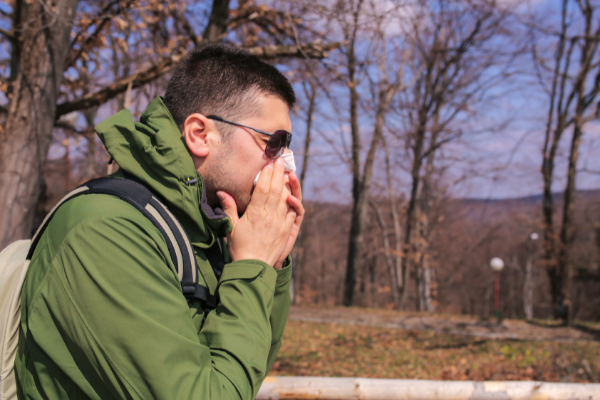Watery, itchy eyes, runny nose, sneezing, coughing, scratchy throat, sinus pain—when seasonal allergies strike, you can be miserable. Seasonal allergies are triggered by plants and pollen at different times of the year. In Southern California, the mild, warm weather means that pollen is present year-round and, unfortunately, many people experience seasonal allergies year-round as well.
Common Causes of Seasonal Allergies
Seasonal allergy triggers can vary by time of year. In many parts of the country, allergens are dormant in the winter, offering a break from symptoms. But in Southern California, seasonal allergies are a year-round reality for many people as pollen spreads easily because of the warm, dry, and windy climate.
Some of the most common culprits of seasonal allergies in Southern California are trees, including ash, eucalyptus, mulberry, olive, oak, sycamore, walnut, and big sagebrush. Tree allergies are especially strong in the first half of the year, from January through June.
Pollen from grass is an extremely common allergen that strikes often in the late spring and early summer. Some of the more common types that cause allergic reactions include rye, bermuda, blue, and oat grasses.
Ragweed, wormwood, sagebrush, Russian thistle are allergens that hit next, reaching their peak in the fall.
How to Reduce Exposure to Seasonal Allergens
So if seasonal allergies are making you suffer, what can you do about it? First, you’ll want to identify the cause of your allergic reactions. Through observation of the timing of your symptoms and your exposure to certain areas and plants, you can often self-diagnose seasonal allergies.
If your allergic reactions are hard to observe or don’t seem consistent, it’s a good idea to visit a specialist who can conduct an exam of your ears, nose, and throat, do a medical history, and may advise an allergy test to pinpoint what’s causing your allergy.
Once you’ve identified triggers of your seasonal allergies, you may be able to effectively reduce your exposure to them.
Be Aware of Pollen Counts
Follow local news or websites that provide pollen forecasts and current pollen levels. On days when pollen counts are high or expected to be high, keep your doors and windows closed, and avoid activities outdoors, especially in the morning, as pollen counts are higher in the morning.
Avoid Pollen Exposure
On days that are very dry and windy, stay indoors or avoid excessive outdoor activity. If you can hire someone or have another family member take responsibility for yard work, pulling weeds, and mowing the lawn, you’ll be able to reduce your exposure to common allergens. If you can’t avoid these tasks, try using a pollen mask. When you’re done working outside, remove the clothes you were wearing and take a shower right away to rinse pollen from your hair and body.
Use Air Filters
In the house, use high-efficiency filters for healthy air filtering. A dehumidifier indoors can keep indoor air dry and clear. In the bedroom, use a portable high-efficiency particulate air (HEPA) filter. Throughout your house, use a vacuum cleaner with a HEPA filter.
Treating Seasonal Allergies
If it’s not possible to reduce your exposure to allergens enough to control your allergies, you can try other treatment options.
Medications, Sprays, and Shots
Many people are able to manage the symptoms of seasonal allergies using over-the-counter allergy medications. Decongestants and antihistamines can bring a lot of relief, but some medications can have side effects such as drowsiness, dizziness, or confusion. Some people need further medications, such as steroid nasal sprays or allergy shots that work as immunotherapy to desensitize your immune system to allergens.
Minimally-invasive Procedures
Some seasonal allergy symptoms can lead to severe nasal congestion and recurrent sinus infections year-round. When allergies trigger sinus and nasal problems, you may benefit from minimally-invasive procedure options.
For patients whose enlarged or inflamed turbinates worsen allergy symptoms, a solution may be minimally invasive in-office turbinate reduction. The turbinates are three sets of small structures in the nose responsible for filtering and humidifying the air we breathe. When functioning properly, the turbinates will filter dirt, pollen, allergens, and other airborne irritants before they reach your lungs.
Chronic sinusitis, which is caused by inflammation of the paranasal sinuses, can result from allergies and leads to headaches, facial and sinus pain, eye discomfort, ear congestion/infection, and even tooth pain. Balloon sinuplasty may be an allergy relief option for some people. It is used to expand sinus pathways by reshaping the anatomy and restoring proper drainage capabilities.
Find a Trusted Provider for Seasonal Allergies
Seasonal allergies are very common, but if they become unmanageable and affect your quality of life, it’s time to seek expert care with a trusted provider.
At C/V ENT Surgical Group, our team of surgeons are highly skilled, experienced, and qualified to perform surgical procedures using our cutting-edge technology and equipment, and compassionate expertise.
Contact us today for a consultation with one of our ENT specialists.


